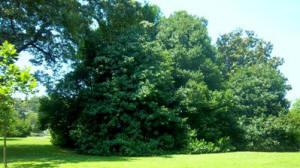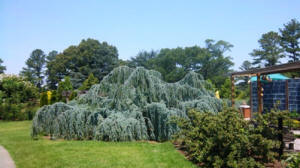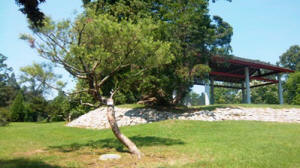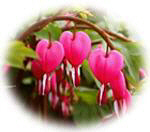By Bonnie Grosshans
A gem in the city, Memphis Botanic Garden encompasses 96 acres and has some unusual and interesting trees on the grounds. With 152 different species of trees, the Garden is classified as a Level IV Arboretum by the Tennessee Urban Forestry Council. This Level IV designation makes the Garden one of four in the state and the only one in West Tennessee. “We estimate there are at least 2000 trees in the Garden – with lots of duplicates,” says Adult Education Manager Laurie Williams. With the vast collection of trees, the Garden serves as a wonderful area for visitors to determine how species of trees would exist in their own landscapes.

One of the first species to be planted in the arboretum was the Ilex latifolia, or Lusterleaf Holly
(pictured at left), noted for its large leaves. The garden specimens are so impressive that noted horticulturist Michael Dirr suggested that the Garden’s logo be changed to honor these plants.
Another unique tree in the Garden is Clerodendrum trichotomum, Harlequin Glory Bower. When its leaves are crushed, there is the brief scent of peanut butter. Butterflies, bees, and birds are especially drawn to this tree and during the fall, the tree produces vivid bright blue fruit that forms on the flower’s center where red calyxes bloom.

Cedrus Atlantica ‘Glauca Pendula,’ the Weeping Blue Atlas Cedar
(pictured at right), is a tree native to the Atlas Mountains of Algeria and Morocco and is a large stunning evergreen that displays a unique lateral growth pattern. “Atlas (species or weeping) is the best true cedar for our area,” says Director of Horticulture Rick Pudwell. It is located in The Children’s Garden and its close relative, the upright version, may be observed nearby in the Conifer Collection.

Because of similar climates, Asian plants thrive in the Garden. Some unique species found on the grounds include Pinus thunbergiana, Japanese Black Pine, Pinus densiflora, Japanese Red Pine
(pictured at left), Castanea mollissima, Chinese Chestnut Tree, and Sciadopitys verticillata, Japanese Umbrella pine. A unique cultivar of a verigated Japanese Red Pine is located in the the Japanese Garden and is especially beautiful in the fall months of the year.

When Glyptostrobus pensilis ‘wooly
mammoth’, Chinese Water Pine
(pictured at
right), was planted about 10 years ago, there were only four
in the United States. It’s a deciduous conifer and the only living species
in the genus – with fossils dating back to the late Cretaceous period. The
Chinese Water Pine is a very rare tree; there is only one on the grounds.
The horticulture staff has successfully propagated them and currently are
caring for several small ones in the Garden nursery and green houses.
With over 800 trees classified on the grounds, the Memphis Botanic Garden offers a living classroom for tree enthusiasts to view, study, photograph or just simply enjoy the beauty and the peaceful surroundings enhanced by this vast array of trees.







 One of the first species to be planted in the arboretum was the Ilex latifolia, or Lusterleaf Holly
(pictured at left), noted for its large leaves. The garden specimens are so impressive that noted horticulturist Michael Dirr suggested that the Garden’s logo be changed to honor these plants.
One of the first species to be planted in the arboretum was the Ilex latifolia, or Lusterleaf Holly
(pictured at left), noted for its large leaves. The garden specimens are so impressive that noted horticulturist Michael Dirr suggested that the Garden’s logo be changed to honor these plants.
 Cedrus Atlantica ‘Glauca Pendula,’ the Weeping Blue Atlas Cedar
(pictured at right), is a tree native to the Atlas Mountains of Algeria and Morocco and is a large stunning evergreen that displays a unique lateral growth pattern. “Atlas (species or weeping) is the best true cedar for our area,” says Director of Horticulture Rick Pudwell. It is located in The Children’s Garden and its close relative, the upright version, may be observed nearby in the Conifer Collection.
Cedrus Atlantica ‘Glauca Pendula,’ the Weeping Blue Atlas Cedar
(pictured at right), is a tree native to the Atlas Mountains of Algeria and Morocco and is a large stunning evergreen that displays a unique lateral growth pattern. “Atlas (species or weeping) is the best true cedar for our area,” says Director of Horticulture Rick Pudwell. It is located in The Children’s Garden and its close relative, the upright version, may be observed nearby in the Conifer Collection.
 Because of similar climates, Asian plants thrive in the Garden. Some unique species found on the grounds include Pinus thunbergiana, Japanese Black Pine, Pinus densiflora, Japanese Red Pine
(pictured at left), Castanea mollissima, Chinese Chestnut Tree, and Sciadopitys verticillata, Japanese Umbrella pine. A unique cultivar of a verigated Japanese Red Pine is located in the the Japanese Garden and is especially beautiful in the fall months of the year.
Because of similar climates, Asian plants thrive in the Garden. Some unique species found on the grounds include Pinus thunbergiana, Japanese Black Pine, Pinus densiflora, Japanese Red Pine
(pictured at left), Castanea mollissima, Chinese Chestnut Tree, and Sciadopitys verticillata, Japanese Umbrella pine. A unique cultivar of a verigated Japanese Red Pine is located in the the Japanese Garden and is especially beautiful in the fall months of the year.
